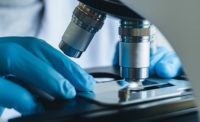Real-time results
How inline monitoring of whey processing helps a Dutch dairy processor
Royal FrieslandCampina uses inline analyzers in whey processing to identify the concentration of substances.

The LiquiSonic analyzer monitors inline concentrations in liquid food for optimal control of production processes.

At a FrieslandCampina dairy processing plant, the LiquiSonic sensor measures the dry matter content in the evaporation of whey.
This article was written by SensoTech and edited by Dairy Foods
Inline measuring allows a dairy processor to detect concentrations of various components in milk or other liquids as they are being processed. Rather than sending samples to a lab (either in-house or outside the plant), a dairy using an inline analyzer can record every little change immediately and continuously.
If limits are exceeded or minimums not met, a dairy processor can take prompt action. In addition to the increased safety and quality of processes, inline measurement can also increase product yield. Processes can be run efficiently. Resources, such as raw materials and energy, can be used optimally.
Royal FrieslandCampina uses inline measurement technology
The Dutch dairy company Royal FrieslandCampina is using inline measurement technology. FrieslandCampina is a manufacturer of dairy products, baby foods and functional dairy ingredients. It operates plants around the world.
The company decided to optimize its whey processing operations with the LiquiSonic analyzer from the German equipment supplier SensoTech. The results of the two-month test were so convincing that the dairy has equipped other plants with the technology. There are over 10 systems in use at FrieslandCampina.
Whey is a by-product of cheesemaking. Whey can be dried or used to produce lactose. The extraction of the whey components serves the manufacturing of semi-finished products for the food industry and the pharmaceutical sector.
The in-line analyzer measures the dry matter content during the whey evaporation at temperatures up to 185F. A production manager explains the process: "We've installed a sensor in the transport line before the evaporator in order to determine the initial concentration. Another sensor is located at the outlet of the evaporator to control the dry matter content and to pointedly stop the evaporation process. This way, we improve the yield of the whey and save energy, because we need less process steam."
In addition to the evaporation, the in-line analyzer is used to monitor the lactose precipitation, protein mother liquor separation and purification processes as well. In the rinsing processes, the aim is fast and accurate phase detection. The dairy wants to differentiate between whey and the cleaning liquids hydroxide and nitric acid in the tank and pipes. At this point, an exact liquid detection is of paramount importance for a quality-assured food production. To be sure that whey is in the pipes and the tank, the factory uses the sensors in various process stages, such as evaporation or filling.
The use of LiquiSonic sensors in dairies
LiquiSonic is used in the processing of milk, cheese and whey. When milk is concentrated, raw milk is separated into cream and skim by membrane filtration. The sensors are installed in the retentate stream in order to measure the concentration continuously. An additional sensor in the permeate can detect intrusions. During the filling, the analyzer monitors the quality of the standardized milk to achieve maximum process safety.
In cheese production, milk is thickened with rennet. Sweet whey is a by-product. At this point, SensoTech advises the incorporation of a sensor for phase detection in the process. Thus, the separation of the curd from the whey can be controlled precisely. The whey that is secreted due to the milk protein coagulation is filtered and its concentration will be monitored continuously by the sensor. Since the by-product is a highly concentrated “nutrient cocktail,” further processing of the whey follows.
Fresh whey does not last long. Its healthy ingredients start to spoil approximately two hours after the extraction. The production of dry whey is done by membrane filtration or evaporation processes. Within this process, water is removed from the whey, so that the dry matter content increases. Also for this application, inline monitoring is recommended to reduce energy costs and assure best quality of the dry whey.
A LiquiSonic sensor is preferably installed in the retentate so a perfect product and resource-saving process management is possible. In addition to processing the whey to a dry product, whey is also used for the production of lactose. In the manufacturing process, a LiquiSonic analyzer is applied to monitor the cooling crystallization and extraction.
Read more about LiquiSonic on the SensoTech website.
About SensoTech
SensoTech’s inline analyzers set standards in the technological and qualitative valence, user friendliness and reproducibility of process values. The company’s headquarters is in Magdeburg-Barleben, Germany, and it has an office in Wayne, N.J.
Looking for a reprint of this article?
From high-res PDFs to custom plaques, order your copy today!








